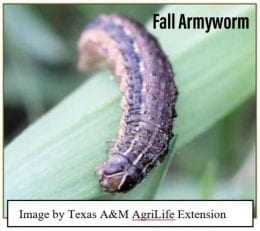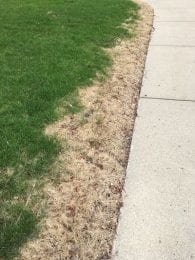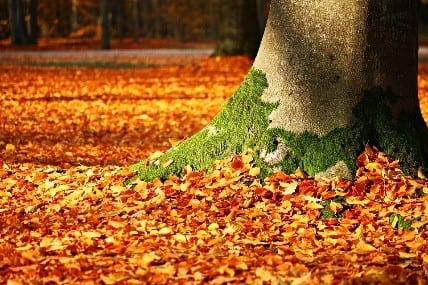This year we have seen an invasion of fall armyworms. Thankfully with cooler temperatures in the forecast, they will soon be gone.
To learn more about fall armyworms follow this link:

By: Cassie Homan
This year we have seen an invasion of fall armyworms. Thankfully with cooler temperatures in the forecast, they will soon be gone.
To learn more about fall armyworms follow this link:

By: Cassie Homan
Winter is here, and with it comes snow and ice. It’s important to also think about your plants during this season. Make sure to use a de-icer that will not harm your lawn and other landscape plants.
There are five main materials that are used as chemical de-icers: calcium chlori de, sodium chloride (table salt), potassium chloride, urea, and calcium magnesium acetate.
de, sodium chloride (table salt), potassium chloride, urea, and calcium magnesium acetate.
Calcium chloride is the traditional ice-melting product. Though it will melt ice to about -25 degrees F, it will form slippery, slimy surfaces on concrete and other hard surfaces. Plants are not likely to be harmed unless excessive amounts are used.
Rock salt is sodium chloride and is the least expensive material available. It is effective to approximately 12 degrees F, but can damage soils, plants and metals. Potassium chloride can also cause serious plant injury when washed or splashed on foliage. Both calcium chloride and potassium chloride can damage roots of plants.
Urea (carbonyl diamide) is a fertilizer that is sometimes used to melt ice. Though it is only about 10% as corrosive as sodium chloride, it can contaminate ground and surface water with nitrates. Urea is effective to about 21 degrees F.
Calcium magnesium acetate (CMA), a newer product, is made from dolomitic limestone and acetic acid (the principal compound of vinegar). CMA works differently than the other materials in that it does not form a brine-like salt but rather helps prevent snow particles from sticking to each other or the road surface. It has little effect on plant growth or concrete surfaces.
Limited use of any of these products should cause little injury. Problems accumulate when they are used excessively and there is not adequate rainfall to wash or leach the material from the area. Since limited use is recommended it is best to remove the ice and snow by hand when possible. When they are applied, practice moderation. Resist the temptation to over apply just to make sure the ice and snow melts. Keep in mind this can damage concrete surfaces as well as the plants and grass growing along the walks and driveways. These problems are normally latent and do not show up until spring or summer.
By: Cassie Homan
If you have a cool season lawn, fall is the time to care for it. This video shows fertilizing tips and tricks.
By: Cassie Homan
 There are five main materials that are used as chemical de-icers: calcium chloride, sodium chloride (table salt), potassium chloride, urea, and calcium magnesium acetate.
There are five main materials that are used as chemical de-icers: calcium chloride, sodium chloride (table salt), potassium chloride, urea, and calcium magnesium acetate.
Calcium chloride is the traditional ice-melting product. Though it will melt ice to about -25 degrees F, it will form slippery, slimy surfaces on concrete and other hard surfaces. Plants are not likely to be harmed unless excessive amounts are used.
Rock salt is sodium chloride and is the least expensive material available. It is effective to approximately 12 degrees F, but can damage soils, plants and metals. Potassium chloride can also cause serious plant injury when washed or splashed on foliage. Both calcium chloride and potassium chloride can damage roots of plants.
Urea (carbonyl diamide) is a fertilizer that is sometimes used to melt ice. Though it is only about 10% as corrosive as sodium chloride, it can contaminate ground and surface water with nitrates. Urea is effective to about 21 degrees F.
Calcium magnesium acetate (CMA), a newer product, is made from dolomitic limestone and acetic acid (the principal compound of vinegar). CMA works differently than the other materials in that it does not form a brine-like salt but rather helps prevent snow particles from sticking to each other or the road surface. It has little effect on plant growth or concrete surfaces.
Limited use of any of these products should cause little injury. Problems accumulate when they are used excessively and there is not adequate rainfall to wash or leach the material from the area. Since limited use is recommended it is best to remove the ice and snow by hand when possible. When they are applied, practice moderation. Resist the temptation to over apply just to make sure the ice and snow melts. Keep in mind this can damage concrete surfaces as well as the plants and grass growing along the walks and driveways. These problems are normally latent and do not show up until spring or summer.
By: Cassie Homan
With cooler temperatures coming, leaves will soon be falling from deciduous trees. It’s a good time to stop and think about options for handling the litter. Although a scattering of leaves won’t harm the lawn, excessive cover prevents sunlight from reaching turfgrass plants. Turf left in this state for an extended period will be unable to make the carbohydrates needed to carry it through the winter.
 There are options for dealing with the fallen leaves other than bagging them up and putting them out for the trash collector. Composting is a great way to handle the excess. Compost can then be used in the vegetable garden and flowerbeds. If you do not compost, you can mow leaves with a mulching mower and let shredded leaves filter into the turf canopy. (A side-discharge mower also will work, but it won’t shred the leaves as thoroughly.) This method will be most effective if you do it often enough that leaf litter doesn’t become too thick. Mow while you can still see grass peeking through the leaves.
There are options for dealing with the fallen leaves other than bagging them up and putting them out for the trash collector. Composting is a great way to handle the excess. Compost can then be used in the vegetable garden and flowerbeds. If you do not compost, you can mow leaves with a mulching mower and let shredded leaves filter into the turf canopy. (A side-discharge mower also will work, but it won’t shred the leaves as thoroughly.) This method will be most effective if you do it often enough that leaf litter doesn’t become too thick. Mow while you can still see grass peeking through the leaves.
You may wonder whether this practice will be detrimental to the lawn in the long run. Research at Michigan State University in which they used a mulching mower to shred up to about one pound of leaves per square yard of lawn (one pound is equal to approximately 6 inches of leaves piled on the grass) for five consecutive years, found no long-term effects of the shredded leaves on turf quality, thatch thickness, organic content of the thatch, or soil test results (pH, nutrients, etc.). If you mow leaves and have a cool-season lawn, it makes sense to be on a fall nitrogen fertilization program and core-aerate in the fall (things you should be doing anyway). If you have a warm-season lawn, you can still use this technique but wait to fertilize and core-aerate until next May or early June.
By: Cassie Homan
Knowing how often and how much to water your lawn can be tricky. With the lack of rain, it may be tempting to over water your grass. However, you can use past weather data from K-State’s Weather Data Library to figure the exact about of Evapotranspiration from your landscape. This will help in knowing how much water has been lost from your lawn and how much needs to be applied. Remember the basic rule of lawn irrigation is to water deeply and infrequently.
Watch this video tutorial to learn more:
By: Cassie Homan